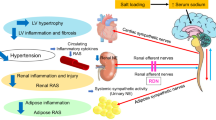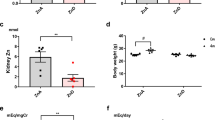Abstract
Heme oxygenase-1 (HO-1) has been well established as a cytoprotective molecule, and has been shown to exert cardioprotective effects in both hypertension and cardiac hypertrophy. However, the precise mechanism of the cardioprotective effect of HO-1 has yet to be fully elucidated. With the natriuretic peptide system (NPS) as a key player in cardiovascular homeostasis and tissue dynamics, we sought to examine the effect of high dietary salt treatment in genetic models of HO-1 expression, and assessed the expression of the NPS in the left ventricle (LV), to determine if the effects of altered HO-1 expression may be due to modified levels of the NPS. Age-matched 12-week old male HO-1 knockout (HO-1−/−) and HO-1 cardiomyocyte-specific transgenic overexpressing (HO-1Tg) mice were treated with either normal salt (NS; 0.8%) or high salt (HS; 8.0%) chow for 5 weeks. LV mRNA expression was determined using quantitative real-time PCR. ANP peptide level was measured in the LV and plasma using radioimmunoassay, and LV cyclic 3′-5′ guanosine monophosphate level was measured using an enzyme immunoassay kit. HO-1−/− fed HS diet had significantly higher left ventricle-to-body weight ratio (LV/BW) compared to HO-1+/+ mice fed NS diet. HO-1−/− mice had significantly reduced expression of the NPS compared to controls, and these mice did not exhibit a salt-induced increase in ANP expression. HS treatment had no noticeable effect on LV/BW in HO-1Tg mice compared to controls. HO-1Tg mice had significantly higher ANP and BNP expression compared to controls. There were no differences in LV cGMP levels among all genotypes and dietary treatments. HO-1 ablation resulted in significantly lower mRNA expression of the NPS, whereas HO-1 overexpression resulted in higher mRNA expression of the NPS. Both were substantiated by peptide levels as measured by RIA. These data indicate that the detrimental effect of reduced HO-1 expression and the cardioprotective effect of increased HO-1 expression may be due, in part, to altered expression of the NPS.









Similar content being viewed by others
References
Idriss NK, Blann AD, Lip GYH (2008) Hemoxygenase-1 in cardiovascular disease. J Am Coll Cardiol 52(12):971–978
Hunter JJ, Chien KR (1999) Signaling pathways for cardiac hypertrophy and failure. N Engl J Med 341(17):1276–1283
John SW, Krege JH, Oliver PM et al (1995) Genetic decreases in atrial natriuretic peptide and salt-sensitive hypertension. Science 267(5198):679–681
Feng JA, Perry G, Mori T et al (2003) Pressure-independent enhancement of cardiac hypertrophy in atrial natriuretic peptide-deficient mice. Clin Exp Pharmacol Physiol 30(5–6):343–349
Rosenkranz AC, Woods RL, Dusting GJ et al (2003) Antihypertrophic actions of the natriuretic peptides in adult rat cardiomyocytes: importance of cyclic GMP. Cardiovasc Res 57(2):515–522
O’Tierney PF, Chattergoon NN, Louey S et al (2010) Atrial natriuretic peptide inhibits angiotensin II-stimulated proliferation in fetal cardiomyocytes. J Physiol 588(15):2879–2889
Chen YH, Yet SF, Perrella MA (2003) Role of heme oxygenase-1 in the regulation of blood pressure and cardiac function. Exp Biol Med 228(5):447–453
Ryter SW, Otterbein LE, Morse D et al (2002) Heme oxygenase/carbon monoxide signaling pathways: regulation and functional significance. Mol Cell Biochem 234–235(1):249–263
Hu CM, Chen YH, Chiang MT et al (2004) Heme oxygenase-1 inhibits angiotensin II-induced cardiac hypertrophy in vitro and in vivo. Circulation 110(3):309–316
Jadhav A, Ndisang JF (2009) Heme arginate suppresses cardiac lesions and hypertrophy in deoxycorticosterone acetate-salt hypertension. Exp Biol Med 234(7):764–778
Mito S, Ozono R, Oshima T et al (2008) Myocardial protection against pressure overload in mice lacking bach1, a transcriptional repressor of heme oxygenase-1. Hypertension 51(6):1570
Wiesel P, Patel AP, Carvajal IM et al (2001) Exacerbation of chronic renovascular hypertension and acute renal failure in heme oxygenase-1-deficient mice. Circ Res 88(10):1088–1094
Yet SF, Parrella MA, Layne MD et al (1999) Hypoxia induces severe right ventricular dilatation and infarction in heme oxygenase-1 null mice. J Clin Invest 103(8):R23–R29
Yet SF, Tian R, Layne MD et al (2001) Cardiac-specific expression of heme oxygenase-1 protects against ischemia and reperfusion injury in transgenic mice. Circ Res 89(2):168–173
Tse MY, Watson JD, Sarda IR et al (2001) Expression of B-type natriuretic peptide in atrial natriuretic peptide gene disrupted mice. Mol Cell Biochem 219(1):99–105
Nath KA, d’Uscio LV, Juncos JP et al (2007) An analysis of the DOCA-salt model of hypertension in HO-1-/- mice and the Gunn rat. Am J Physiol Heart Circ Physiol 293(1):H333–H342
Lopez MJ, Wong SKF, Kishimoto I et al (1995) Salt-resistant hypertension in mice lacking the guanylyl cyclase-A receptor for atrial natriuretic peptide. Nature 378(6552):65–68
Kuhn M, Holtwick R, Baba HA et al (2002) Progressive cardiac hypertrophy and dysfunction in atrial natriuretic peptide receptor (GC-A) deficient mice. Heart 87(4):368–374
Knowles JW, Esposito G, Mao L et al (2001) Pressure-independent enhancement of cardiac hypertrophy in natriuretic peptide receptor A-deficient mice. J Clin Invest 107:975–984
Sangaralingham SJ, Tse MY, Pang SC (2007) Estrogen delays the progression of salt-induced cardiac hypertrophy by influencing the renin-angiotensin system in heterozygous pro ANP gene-disrupted mice. Mol Cell Biochem 306(1):221–230
Angelis E, Tse MY, Pang SC (2005) Interactions between atrial natriuretic peptide and the renin-angiotensin system during salt-sensitivity exhibited by the proANP gene-disrupted mouse. Mol Cell Biochem 276(1):121–131
Imai T, Morita T, Shindo T et al (2001) Vascular smooth muscle cell-directed overexpression of heme oxygenase-1 elevates blood pressure through attenuation of nitric oxide-induced vasodilation in mice. Circ Res 89(1):55–62
Stone JR, Marletta MA (2002) Soluble guanylate cyclase from bovine lung: activation with nitric oxide and carbon monoxide and spectral characterization of the ferrous and ferric states. Biochemistry 33(18):5636–5640
Clemo HF, Baumgarten CM (1995) cGMP and atrial natriuretic factor regulate cell volume of rabbit atrial myocytes. Circ Res 77(4):741–749
Nachshon S, Zamir O, Matsuda Y et al (1995) Effects of ANP receptor antagonists on ANP secretion from adult rat cultured atrial myocytes. Am J Physiol Endocrinol Metab 268(3):E428–E432
Rybalkin SD, Rybalkina IG, Shimizu-Albergine M et al (2003) PDE5 is converted to an activated state upon cGMP binding to the GAF A domain. EMBO J 22(3):469–478
Takimoto E, Champion HC, Li M et al (2005) Chronic inhibition of cyclic GMP phosphodiesterase 5A prevents and reverses cardiac hypertrophy. Nat Med 11(2):214–222
Gradin K, Hedner J, Hedner T et al (1987) Effects of chronic salt loading on plasma atrial natriuretic peptide (ANP) in the spontaneously hypertensive rat. Acta Physiol Scand 129(1):67–72
Kiemer AK, Gerwig T, Gerbes AL et al (2003) Kupffer-cell specific induction of heme oxygenase 1 (hsp32) by the atrial natriuretic peptide—role of cGMP. J Hepatol 38(4):490–498
Kiemer AK, Bildner N, Weber NC et al (2003) Characterization of heme oxygenase 1 (heat shock protein 32) induction by atrial natriuretic peptide in human endothelial cells. Endocrinology 144(3):802–812
Sangawa K, Nakanishi K, Ishino K et al (2004) Atrial natriuretic peptide protects against ischemia-reperfusion injury in the isolated rat heart. Ann Thorac Surg 77(1):233–237
Zhang WW, Hasaniya NW, Premaratne S et al (2008) Atrial natriuretic peptide protects against ischemia-reperfusion injury in rabbit hearts in vivo. Vasc Endovasc Surg 42(3):263–267
Liu X, Pachori AS, Ward CA et al (2006) Heme oxygenase-1 (HO-1) inhibits postmyocardial infarct remodeling and restores ventricular function. FASEB J 20(2):207–216
Liu X, Simpson JA, Brunt KR et al (2007) Preemptive heme oxygenase-1 gene delivery reveals reduced mortality and preservation of left ventricular function 1 yr after acute myocardial infarction. Am J Physiol Heart Circ Physiol 293(1):H48–H59
Shiraishi I, Melendez J, Ahn Y et al (2004) Nuclear targeting of Akt enhances kinase activity and survival of cardiomyocytes. Circ Res 94(7):884–891
Tsujita Y, Muraski J, Shiraishi I et al (2006) Nuclear targeting of Akt antagonizes aspects of cardiomyocyte hypertrophy. PNAS 103(32):11946–11951
Matsui T, Rosenzweig A (2005) Convergent signal transduction pathways controlling cardiomyocyte survival and function: the role of PI 3-kinase and Akt. J Mol Cell Cardiol 38(1):63–71
Acknowledgments
The authors thanked the generosity of Dr. Shaw-Fang Yet of the National Health Research Institutes, Taiwan for the provision and permission of using her HO-1−/− and HO-1Tg mice for the current study. DWJA was supported by a Master’s Studentship Award from the Heart and Stroke Foundation of Ontario. Financial support from the Heart and Stroke Foundation of Ontario to SCP (Grant #: T-6108) and LGM (Grant #: NS 5520) and the Canadian Institutes of Health Research to LGM (Grant #: MOP 60500) is gratefully acknowledged.
Author information
Authors and Affiliations
Corresponding author
Rights and permissions
About this article
Cite this article
Armstrong, D.W.J., Tse, M.Y., Melo, L.G. et al. Altered expression of the natriuretic peptide system in genetically modified heme oxygenase-1 mice treated with high dietary salt. Mol Cell Biochem 346, 57–67 (2011). https://doi.org/10.1007/s11010-010-0591-6
Received:
Accepted:
Published:
Issue Date:
DOI: https://doi.org/10.1007/s11010-010-0591-6




